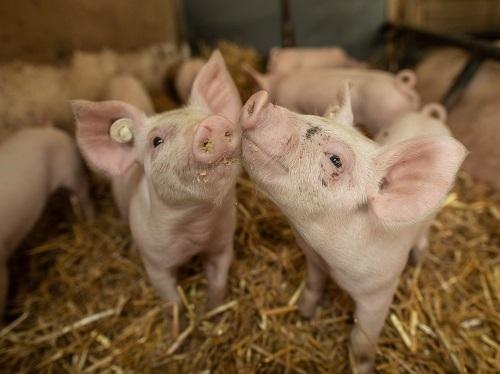关于回肠炎,你应该知道的7个事实
回肠炎会导致猪体重增加缓慢、腹泻,甚至猝死,给全球猪肉行业造成重大经济损失。致病原因是什么?胞内劳森氏菌会感染猪肠道内的细胞,主要损害小肠。为了帮助猪肉生产商应对胞内劳森氏菌感染,乐虎游戏汇总了七个基本事实。

1.最近的一项研究再次证实:胞内劳森氏菌存在于大多数欧洲畜群中
最近对去年暴发腹泻的144个欧洲猪群进行的一项调查发现,高达90%的猪群曾接触过胞内劳森氏菌。1。从这项研究中可以清楚地看出,胞内劳森氏菌普遍存在,而且是一个非常严重的问题。

2.受感染的猪会迅速感染猪舍中的其他猪
在评估未接种疫苗的猪体内劳森氏菌的传播率时,科学家们表明,一只被感染的猪每周能够感染三头易感猪。2。在未受保护的猪群中,受感染猪的数量每周可以增加三倍。
3.接种疫苗可减少劳森氏菌胞内传播
重要的是实施系统的疫苗接种计划,以减轻回肠炎的传播以及相关的生长迟缓情况。在一项研究中2,与未受保护的猪群相比,口服活疫苗可以显著降低传播率。
4.局部免疫对于防止胞内劳森氏菌至关重要
胞内劳森氏菌感染仅限于肠道,这就是为什么局部免疫 - 即仅限于特定器官或组织的免疫 - 至关重要的原因。一种理想的针对回肠炎的疫苗应该能够引发平衡的免疫反应 - 包括局部免疫和细胞免疫 - 从而消除病原体。口服疫苗已被证明可在肠道层面诱导早期局部免疫。3。
5.胞内劳森氏菌感染对肠道微生物组的破坏会对猪的健康和生产力产生广泛的影响
众所周知,肠道消化菌群(或微生物群)会影响猪的健康和生产力,而胞内劳森氏菌感染似乎会产生令人不安的影响。感染会增加对沙门氏菌的易感性。4。这对你的养殖场来说意味着什么?很简单:胞内劳森氏菌的行为就像是其他病菌的开门者。

6.口服疫苗可减少胞内劳森菌的脱落,并影响微生物组
接种了疫苗的猪的微生物群落似乎与未接种疫苗和患病猪的微生物群落不同5。这种变化与胞内劳森氏菌粪便脱落的急剧减少有关,表明口服疫苗可以对肠道微生物组的组成、猪的生产能力和病原体的传播产生积极影响6,7。
7.猪肉生产商需要针对回肠炎采取定期控制措施
所有这些科学发现对你的养殖场意味着什么?随着乐虎游戏减少对抗生素的依赖,很明显乐虎游戏需要对胞内劳森氏菌实施定期控制措施。口服疫苗是一种简单、对猪友好、有效且具有成本效益的方法,可减轻养殖场的回肠炎负担。可以咨询你的兽医,了解如何为你实施最佳控制方案。
参考文献
1 Arnold et al 2019:
2 Vasquez et al, 2019: Impact of vaccination on transmission of Lawsonia intracellularis
Erika Vasquez1 ; Robert Valeris1 ; Dana Beckler2 ; Fabio Vannucci1
50th Annual Meeting of the American Association of Swine Veterinarians (Orlando; March 9-12, 2019)
1College of Veterinary Medicine, University of Minnesota; 2Gut Bugs, Inc, Minnesota
Experimental design
A seeder-pig sentinel model was used (Figure 1). Ninety pigs were divided into three groups: orally vaccinated (Enterisol Ileitis); intramuscularly vaccinated (Porcilis Ileitis) and non-vaccinated. Day 21 post-vaccination, nine seeder pigs were challenged with L. intracellularis. Day 7 post-inoculation, seeder pigs were commingled as described in Figure 1.
Transmission rate and expected probabilities of shedding were assessed with the susceptible-infectious model. Animals were considered infectious when fecal quantitative polymerase chain reaction was equal or more than 103L. intracellularis per gram of feces (Collins et al, 2001).
In practical terms, this would roughly represent a threshold cycle of 31 or less based on the PCR assay offered by the University of Minnesota Veterinary Diagnostic Laboratory.
Results and practical implications
- Vaccination against L. intracellularis has been applied over the years with successful reduction of the clinical signs and fecal shedding, and resulting in significant improvement of growth performance in vaccinated animals.
- The assessment of the transmission rate under a non-vaccinated scenario showed that one infectious pig (shedding more than 103 bacteria per gram of feces) is able to transmit L. intracellularis to three susceptible pigs per week.
- From a practical standpoint, if pigs from infected and naïve flows are commingled at 10 weeks of age (end of the nursery phase) the number of infected pigs triplicate within the population every week.
- The results revealed that the chronic nature of the Lawsonia infection at the individual level is also reflected in the transmission of the disease at the population level characterizing a prolonged spreading of the infection in the finishing barn.
- Although the Lawsonia infection can impact the productive performance in the first weeks of the finishing phase when naïve pigs just started getting infected, the clinical diagnosis is only evident when most of the naïve population is infected and some animals are exhibiting diarrhea. This typical clinical scenario is usually observed only at later stages of the finishing phase when the animals are approaching the marketing age and it can misrepresent the actual impact of the disease in terms of performance throughout the growing-finishing phase.
- In the present study, transmission rates were significantly reduced in both vaccinated groups: 1.8 infected pig per week in the orally-vaccinated and 1.7 infected pig per week in the intramuscularly-vaccinated group.
- The model used to predict transmission over time also showed decreasing in the period of fecal shedding of Lawsonia in both vaccinated groups. While the median period of shedding in non-vaccinated animals was 11.2 weeks, orally- and intramuscularly-vaccinated animals showed 6.3 and 8.3 weeks, respectively.
These results highlight the importance of implementing vaccination programs at system level rather than site-specific interventions. This strategy prevents the risk of commingling batches of pigs from vaccinated and non-vaccinated sources, therefore reducing the impact of the disease in downstream flows.
3 Nogueira et al, 2013:
4 Beloeil et al, 2004:
5 Guevarra et al, 2021:
6 Leite et al, 2021:
7 Helm et al, 2021:
相关内容

中国率先发布针对非洲猪瘟的生物安全报告



请扫码关注乐虎游戏
乐虎游戏 官方
乐虎游戏 HR
乐虎游戏 动保